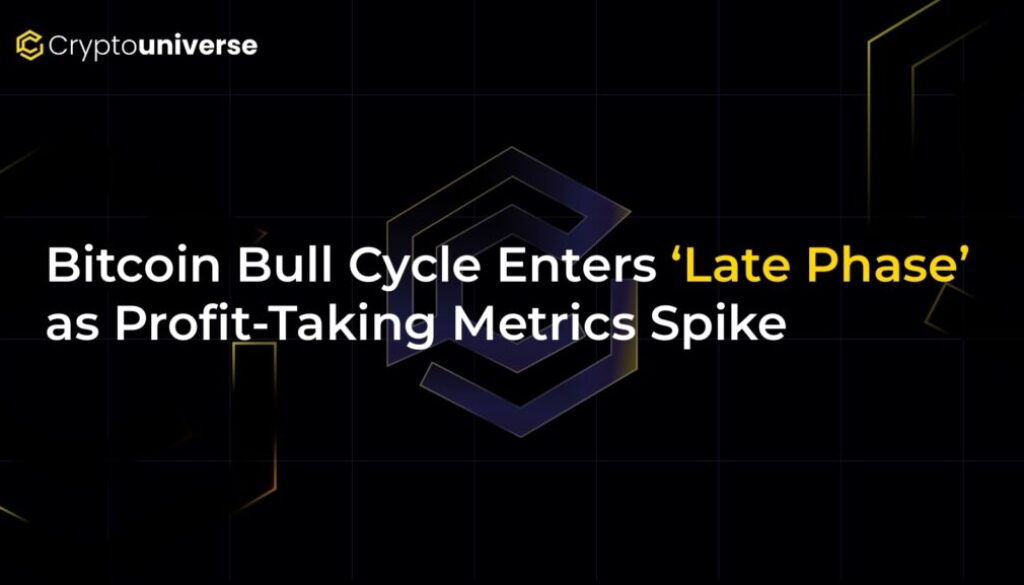Bitcoin Bull Cycle Enters ‘Late Phase’ as Profit-Taking Metrics Spike

Is the Bitcoin Bull Run Nearing Its End, or Just Getting Started?
The crypto market is buzzing with a mix of excitement and anxiety. On one hand, Bitcoin continues to trade at impressive levels. On the other, whispers of a market top are growing louder. According to leading on-chain analytics firm Glassnode, the current
This article dives deep into the on-chain data to unpack the signals, explore the battle between long-term holders and new investors, and provide a clearer picture of what might come next for Bitcoin.
Decoding the “Late Phase” Warning Signs
Glassnode’s analysis points to several key indicators suggesting the market is in a mature stage of its bull cycle. This isn’t just speculation; it’s based on historical data and investor behavior that has proven reliable in the past.
1. Extended Time in the “Profit Zone”
One of the most compelling signals is the length of time Bitcoin’s price has remained in a high-profitability state. The data shows Bitcoin’s circulating supply has spent 273 consecutive days above the +1 standard deviation profit band. This is a technical way of saying that a vast majority of holders are sitting on significant unrealized gains. This streak is second only to the 335-day period seen during the epic 2015–2018 bull run, placing the current market in a historically significant position.
2. Long-Term Holders Are Cashing Out
Long-Term Holders (LTHs)—wallets that have held Bitcoin for over 155 days—are beginning to take profits. Historically, these seasoned investors tend to sell into strength, distributing their coins to newer market participants as the cycle heats up. According to Glassnode, LTHs have already realized more profits in this cycle than in almost any previous one, signaling that sell-side pressure is steadily mounting.
“These signals reinforce the view that the current cycle is firmly in its historically late phase,” Glassnode noted in its weekly report. However, they also added a crucial piece of context: in past cycles, these very conditions have often preceded new all-time highs within two to three months.
Capital Flows Weaken, But Demand Persists
Since hitting a staggering $124,000, Bitcoin has seen a nearly 9% pullback. This price action is accompanied by weakening capital inflows, a key metric for market momentum.
The growth of Bitcoin’s Realized Cap—a measure of the total value of all coins at the price they were last moved—peaked at just 6% per month recently. This is a noticeable slowdown compared to the 13% growth seen during the breakout past $100,000 in late 2024. Profit-taking volumes have also softened, with the latest all-time high attempt seeing significantly less realized profit than the spikes at $70,000 and $100,000.
Despite this, there’s a powerful counter-narrative unfolding. While long-term players are selling, a new wave of investors is eagerly buying.
- New Holders Arrive: Data from CryptoQuant shows that the youngest cohort of Bitcoin wallets (less than one month old) has flipped net positive, adding over 73,700 BTC in September alone.
- Short-Term Holders Accumulate: Short-Term Holders (STHs) are also aggressively buying, having accumulated nearly 160,000 BTC. This new capital is effectively absorbing the supply being sold by LTHs, a dynamic essential for a sustained bull market.
- Whales Are Still Hungry: Large wallets holding between 10 and 10,000 BTC have added over 56,000 coins since late August, indicating that smart money remains confident.
- Coins Leave Exchanges: Over 31,000 BTC has moved off exchanges in the past month, reducing the immediately available supply for selling and suggesting a longer-term holding strategy among buyers.
A Word of Caution: Retail Sentiment and Market Headwinds
While the accumulation trends are bullish, other metrics urge caution. On-chain insights from Santiment suggest that retail traders’ eagerness to “buy the dip” has historically been a contrarian indicator, often preceding further price drops. Market sentiment has soured since Bitcoin fell below $114,000, but fear levels haven’t reached the point of capitulation that typically marks a definitive bottom.
Furthermore, the market currently lacks a significant volume of short positions. This means there is little fuel for a major “short squeeze”—a rapid price increase forced by short-sellers buying back to cover their positions—which has often propelled prices higher in the past.
Conclusion: A Tug-of-War at a Critical Juncture
The Bitcoin market is at a fascinating crossroads. On one side, seasoned investors are taking profits, and capital momentum is slowing—classic signs of a late-stage bull run. On the other, a fresh wave of demand from new holders, short-term traders, and whales is providing strong support, absorbing the sell pressure and keeping the dream of higher prices alive.
History suggests that being in the “late phase” doesn’t mean the party is over. It could simply be the prelude to a final, parabolic climax. While a correction is always possible, the strong underlying demand and continued accumulation by key players suggest that another all-time high may still be on the table before this cycle is truly complete.


